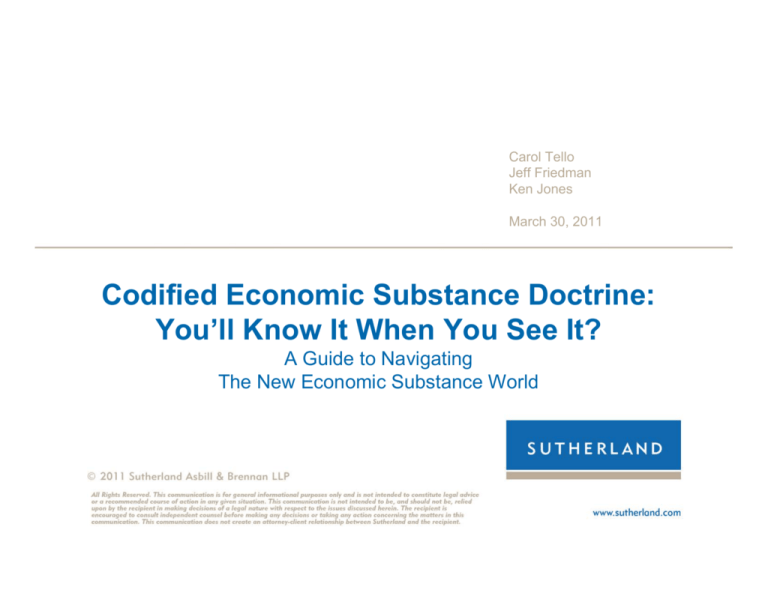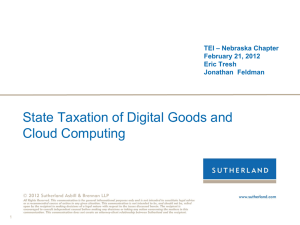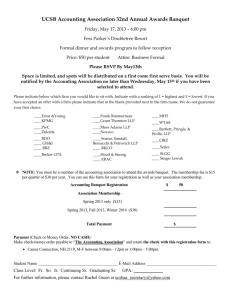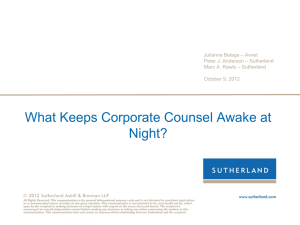Codified Economic Substance Doctrine
advertisement

Carol Tello Jeff Friedman Ken Jones March 30, 2011 Codified Economic Substance Doctrine: You’ll Know It When You See It? A Guide to Navigating The New Economic Substance World Speakers Carol Tello Partner Sutherland Asbill & Brennan LLP Ken Jones Of Counsel Sutherland Asbill & Brennan LLP Jeff Friedman Jeremiah Coder Partner Sutherland Asbill & Brennan LLP Contributing Editor Tax Analysts ©2011 Sutherland Asbill & Brennan LLP Today’s Agenda • • • • § 7701(o) Key Provisions IRS Guidance? Key Issues/Concerns SALT ©2011 Sutherland Asbill & Brennan LLP Why Are We Talking About Codified Economic Substance If Nothing Has Changed? • Stakes are raised Strict liability penalty – 20% if disclosure, 40% if no disclosure No reasonable cause No protection from opinion of counsel • No “Angel” List – Notice 2010-62 (September 13, 2010) Joint Committee Report (JCX-18-10) March 21, 2010 Capitalization: debt vs. equity Foreign vs. U.S. corporation for foreign investment Corporate reorganizations Use of related party entity (assuming § 482 is met) Prior legislative proposal provided a list of applicable transactions • Conjunctive test – All transactions must have both Business purpose (subjective test) and Economic substance (objective test) • Case law differed as to whether satisfaction of one test (disjunctive test) satisfied economic substance ©2011 Sutherland Asbill & Brennan LLP § 7701(o) – Clarification of Economic Substance Key Statutory Provisions • • • Applies to transactions entered into on or after March 31, 2010 Applies to any transaction to which the economic substance doctrine is “relevant,” which is determined as if the law had never been enacted “Nondisclosed noneconomic substance transaction” results in a 40% penalty with no reasonable cause exception Compare to treatment of listed or reportable transactions that permit reasonable cause if adequate disclosure on return and identified characteristics • Transaction treated as having economic substance if: The transaction changes in a meaningful way the taxpayer’s economic position (not including federal, state, or local tax effects) and The taxpayer has a substantial business purpose for the transaction • Conjunctive test required to clarify disparity among circuits ©2011 Sutherland Asbill & Brennan LLP § 7701(o) – Clarification of Economic Substance (Cont’d) • Aggregation and disaggregation permitted The term “transaction” includes a series of transactions Transactions may be disaggregated Coltec Industries v. U.S., 62 Fed. C. 716 (2004) • A financial accounting benefit is not a qualifying purpose if the origin of the benefit is a reduction of federal income tax • Meaningful change in economic position is not required to be measured by profit potential ©2011 Sutherland Asbill & Brennan LLP § 7701(o) – Clarification of Economic Substance (Cont’d) • If taxpayer relies on profit potential, the present value of the reasonably expected pre-tax profit must be “substantial” in relation to the present value of the expected net tax benefits Fees and other transaction expenses will be taken into account to determine pre-tax profit Long Term Capital Holding v. U.S., 330 F. Supp. 2d 122 (D. Conn. 2004) Rice’s Toyota World v. Com’r, 752 F. 2d 89 (4th Cir. 1985) Goldstein v. Com’r, 364 F. 2d 734 (2d Circuit 1966) Knetsch, 364 U.S. 361 (1960) Regulatory authority provided for treatment of foreign taxes Treatment of foreign taxes as expenses to determine pre-tax profit would overrule Fifth and Eighth Circuits in Compaq and IES decisions, respectively ©2011 Sutherland Asbill & Brennan LLP Notice 2010-62 (September 13, 2010) Key Points • • • • Existing case law will apply to determine if a transaction has economic substance and business purpose IRS will challenge a taxpayer that relies on prior disjunctive test case law Whether economic substance applies is made in the same manner as under prior case law Section 7701(o) is “relevant” only if the economic substance doctrine is relevant If prior case law provided that economic substance was not relevant, the IRS will continue to take that position However, the IRS anticipates that the case law pertaining to when economic substance is relevant will “continue to develop” ©2011 Sutherland Asbill & Brennan LLP Notice 2010-62 (Cont’d) • Net present value calculations Apply existing relevant case law and other published guidance Notice 98-5 even though withdrawn? • Treatment of foreign taxes as expenses IRS will issue regulations under § 7701(o)(2)(B) “In the interim” the enactment of § 7701(o) does not restrict the ability of courts to consider appropriate treatment of foreign taxes Compare to JCT Technical Explanation statement If IRS issues regulations treating foreign taxes as expenses, what is the impact on Appeals cases and litigation? IRS won in Tax Court in Compaq and IES cases but lost in circuit courts No further cases Prior proposed legislation required foreign taxes to be treated as expenses ©2011 Sutherland Asbill & Brennan LLP Notice 2010-62 (Cont’d) • Accuracy-related penalties Adequate disclosure requirements of § 6662(i) satisfied by Form 8275 or 8275-R Disclosure made under Rev. Proc. 94-69 “taken into account” Reportable transactions must meet above requirements in addition to § 6011 regulatory requirements • No PLRs or Determination Letters on whether economic substance is “relevant” ©2011 Sutherland Asbill & Brennan LLP Codified Economic Substance Doctrine: You’ll Know It When You See It? Self-Help: The Only Game In Town ©2011 Sutherland Asbill & Brennan LLP When Is Economic Substance Relevant? • ACM Partnership v. Com’r, T.C. Memo 1997-115 “The doctrine of economic substance becomes applicable, and a judicial remedy is warranted, where a taxpayer seeks to claim tax benefits, unintended by Congress, by means of transactions that serve no economic purpose other than tax savings” ©2011 Sutherland Asbill & Brennan LLP When Is Economic Substance Relevant? (Cont’d) • Is economic substance relevant when a transaction has no economic purpose other than tax savings? • If so, then § 7701(o) inquires whether there is economic substance and business purpose • Creates a circular test—a transaction is tested for economic substance only when it has no economic purpose other than tax benefits ©2011 Sutherland Asbill & Brennan LLP Testing for Relevance • Is the outcome of the transaction consistent with all applicable Code provisions? • Is the outcome consistent with the purposes of those applicable Code provisions? • Treas. Reg. § 1.269-2 disallows tax benefits when the effect of the benefit would be to distort the liability of the taxpayer when the essential nature of the transaction is examined in light of the basic purpose of the benefit JTC examples: tax credits (§§ 42, 45, 45D, 47, and 48) where the taxpayer makes the type of investment or undertakes the type of activity the credit was intended to encourage ©2011 Sutherland Asbill & Brennan LLP When Is Economic Substance Met? • Does tax result rely on the interaction of highly technical tax law provisions? JCT Technical Explanation: The fact that a transaction meets the requirements for specific treatment under any provision of the Code is not determinative of whether a transaction or series of transactions of which it is a part has economic substance • Aggregation/disaggregation/recharacterization creates multiple inquiries concerning the same transaction Test each step and the whole? Consider all possible recharacterizations? ©2011 Sutherland Asbill & Brennan LLP “Meaningful Change in Economic Position” • • Treatment of foreign taxes is not necessarily a factor under general meaningful change in economic position Compare costs to potential for economic gain? Approach of Rice’s Toyota World, Inc. v. Com’r, 752 F. 2d 89 (4th Cir. 1985). Limited residual value in assets subject to purchase/leaseback transaction Taxpayer could easily walk away from the transaction from an economic perspective because paid more than fair market value, i.e., no equity in property • • No minimum return required When is there no meaningful change in economic position? Circular cash flow or other circular asset transfers Protection from risk Cash or asset will be returned to original party (or its related party) when transaction is complete ©2011 Sutherland Asbill & Brennan LLP Application of Profit Potential Test • Present value of the reasonably expected pre-tax profit from the transaction must be “substantial” in relation to the present value of the expected net tax benefits No guidance on what is “substantial” What rate of return is required? What discount rate must be applied for present value? No guidance on what “net” tax benefits are • • Optional test – may rely on more general meaningful change in economic position test Fees and other transaction expenses must be taken into account to determine pre-tax profit No guidance on whether fees and other expenses must be directly related to the tested transaction ©2011 Sutherland Asbill & Brennan LLP Foreign Taxes Should Not Be Treated as Expenses • The reference to “pre-tax” profit refers to profits as determined prior to the imposition of federal level income taxes To determine “pre-tax” profit, federal income taxes are not treated as deductions. See § 275(a)(1) and (2) • State taxes are not subject to the same limitation as federal taxes and are permitted as a deduction. See § 164(a)(1) and (2) This is because state taxes are imposed generally on the same income base as are federal income taxes and, in the judgment of Congress, the tax burden would be too high if no deduction were permitted for state taxes ©2011 Sutherland Asbill & Brennan LLP Foreign Taxes Should Not Be Treated as Expenses (Cont’d) • Foreign taxes are imposed only on foreign source income and not on U.S. source income • The credit for foreign taxes is provided to eliminate double taxation at the federal level and substitute dollar-for-dollar for U.S. federal income taxes imposed on foreign source income of a U.S. taxpayer The credit for foreign taxes also recognizes the source country’s prior claim to tax the foreign source income.* Thus, creditable foreign income taxes are treated as equivalent to those imposed by the federal government. As such, they cannot be treated as an expense in determining “pre-tax” profit just as U.S. federal income taxes are not *This assumes that for the most part, U.S. and foreign source rules will be consistent ©2011 Sutherland Asbill & Brennan LLP Lessons Learned: Cases Taxpayer Won – United Parcel Service • United Parcel Service v. Com’r, 78 T.C.M. 262 (1999), rev’d. 254 F.3d 1014 (11th Cir 2001) • Taxpayer undertook a reinsurance transaction that was consistent with its business • Choosing one business form over another solely for tax purposes still satisfied the business purpose test • Eleventh Circuit compared to choice between debt or equity capitalization Similar to JCT Technical Explanation statement • Transaction arguably only altered the form of an existing business ©2011 Sutherland Asbill & Brennan LLP Lessons Learned: Cases Taxpayer Won – Countryside Limited Partnership • Countryside Limited Partnership v. Com’r, T.C. Memo 2008-3 Deferral of income • Admitted tax-motivated transaction had genuine nontax business purpose • Exit strategy from investment partnership with an unrelated party ©2011 Sutherland Asbill & Brennan LLP Lessons Learned: Cases Taxpayer Won – Granite Trust v. U.S. • Granite Trust Co. v. United States, 238 F.2d 670 (1st Cir. 1956) Court upheld loss recognized as a result of a § 331 liquidation that was preceded by the sale of 21% of subsidiary IRS official has confirmed that codification of economic substance would not change this result Tax loss reflects a real economic loss ©2011 Sutherland Asbill & Brennan LLP Lessons Learned: Cases Taxpayer Won – Caruth Corp. v. U.S. • Caruth Corp. v. U.S., 865 F.2d 644 (5th Cir. 1989) • Taxpayer contributed preferred shares to corporation prior to payment of large dividend • Shares of transferee corporation contributed to charitable organization, which realized the benefit of the dividend from the preferred shares • Change in economic position of taxpayer because taxpayer’s remaining shares in dividend-paying corporation were worth less • Business purpose of transaction was in part to induce minority shareholders to sell out to taxpayer ©2011 Sutherland Asbill & Brennan LLP Lessons Learned: Cases Taxpayer Lost • Transactions unrelated to business activity of taxpayer and not in ordinary course of business • Transactions not in accordance with commercial practices in the relevant industry • Economic risks and profit potential insignificant compared to tax benefits • No genuine obligation with an unrelated party • Transactions conducted with tax-indifferent parties • Tax losses not reflected in economic situation ©2011 Sutherland Asbill & Brennan LLP Applying § 7701(o) • • • Corp X, a Canadian corporation, wanted to buy a U.S. manufacturing plant from unrelated Canadian Corp Y. With the advice from its accountants and pursuant to a plan, it effected the acquisition as follows: 1. Corp X’s Canadian subsidiary, CSub, purchased the plant’s inventory on Date 1 CSub used this inventory as security as part of the financing of the total acquisition ($51.6M). 2. On Date 2, CSub transferred this inventory to USCo, a domestic subsidiary of both Corp X and CSub. USCo then transferred the inventory to USSub, a member of USCo’s consolidated group Under former § 357(c), the transferor recognized gain on the contribution equal to the excess of the liabilities assumed by the transferee over the basis of the inventory and under § 362(a)(1) (pre-362(d), the inventory basis was increased by the amount of that gain CSub, as a Canadian corporation, was not subject to U.S. tax on that gain On Date 3, the inventory was sold by USSub at a loss because of the increased basis, which was greater than the FMV of the inventory 3. USSub purchased the remaining plant assets As a result of this transaction, the gain was not subject to U.S. tax, but the loss offset otherwise U.S. taxable income Was there economic substance to this transaction? Corp X Canada 1 Inventory CSub Canada Corp Y Cash Canada Cash 2 3 Contributions USCo US Remaining Plant Assets USSub US ©2011 Sutherland Asbill & Brennan LLP Applying § 7701(o) • Historic Boardwalk Hall, LLC v. Com’r, 136 T.C. No. 1 (filed Jan. 3, 2011) Court rejected the IRS argument that a rehabilitation tax credit investment transaction was a sham that lacked economic substance. IRS unsuccessfully argued that the LLC served only as a mechanism to sell tax credits Court agreed with the taxpayer that the tax credits should be considered in determining whether the transaction had economic substance, noting that one of the primary purposes for § 47 was to “encourage taxpayers to participate in what would otherwise be unprofitable activity” Compare Va. Historic Tax Credit Fund 2001 LP v. Commissioner, T.C. Memo. 2009-295 (4th Cir. March 29, 2011) ©2011 Sutherland Asbill & Brennan LLP Strict Liability Penalty • • • New § 6662(b)(6) applies the accuracy-related penalty to any disallowance of claimed tax benefits by reason of a transaction lacking economic substance (within the meaning of § 7701(o)) or failing to meet the requirements of any similar rule of law No statutory definition of what is “any similar rule of law” JCT Technical Explanation: It is intended that the penalty would apply to a transaction the tax benefits of which are disallowed as a result of the application of the similar factors and analysis that is required under the provision for an economic substance analysis, even if a different term is used to describe the doctrine Step transaction doctrine? Sham doctrine? Substance over form? ©2011 Sutherland Asbill & Brennan LLP What’s Next? • IRS guidance re: coordination of strict liability penalty LB&I Directive (9/14/2010) requires field operations director approval for assertion of section § 6662(b)(6) economic substance penalty, to ensure uniform application of the strict liability penalty Chief Counsel review likely but no formal announcement LB&I plans internal directions and guidance for auditors Apply traditional examination techniques to determine if tax benefit meets tax law requirements TIGTA report “Penalty Cases for Failure to Disclose Reportable Transactions Were Not Always Fully Developed” – found that the procedures for documenting and assessing the § 6707A penalty were not sufficient or formalized and cases not fully developed ©2011 Sutherland Asbill & Brennan LLP What’s Next? • • • • • • Will IRS internal review of proposed assertion of penalty “chill” assertion at the Examination level? Prior to enactment of § 7701(o), IRS frequently relied upon economic substance as a basis to deny a tax benefit. If they now must assert a penalty, which must be reviewed, what will be the impact? How will the potential assertion of the penalty affect audits? Will auditors “threaten” the application to gain leverage? Other consequences? Will auditors who assert the penalty be required to develop more detailed reasons for application? Will prior cases be the only guide for application? Will IRS find new ways to apply economic substance in unanticipated situations? What would be the impact of such an unanticipated application on the penalty? ©2011 Sutherland Asbill & Brennan LLP Take-Aways – Key Issues • How do you determine that § 7701(o) is relevant (should you assume that it may be)? • What is the transaction for § 7701(o) purposes (assume that the transaction(s) will be aggregated and disaggregated)? • No angel lists – but will a PLR provide you with a “halo”? • What is the value of an opinion on economic substance in light of the strict liability penalty? ©2011 Sutherland Asbill & Brennan LLP You’ll Know It When You See It? • The economic substance doctrine “is a living doctrine, and in order to have some vitality it has to have the freedom to be explored and developed” William Alexander, IRS Associate Chief Counsel (Corporate) (from reported remarks at the University of Chicago Annual Federal Tax Conference, November 12, 2010) ©2011 Sutherland Asbill & Brennan LLP Overview • Background: The Hot Mess of Business Purpose and Economic Substance for State Tax Purposes • Conformity with IRC Sec. 7701(o) • Conformity with the IRC Penalty Provisions State reference to the IRC through state conformity ©2011 Sutherland Asbill & Brennan LLP Background: The Hot Mess (cont’d) • Transactions With Economic Substance The Sherwin-Williams Co. v. Comm’r of Revenue, 778 N.E.2d 504 (Mass. 2002) A taxpayer formed two subsidiary corporations and transferred to them all of its domestic trademarks. The taxpayer and its two subsidiaries entered into a licensing agreement that licensed most, but not all, of the marks back to the corporation in exchange for a royalty. The Board disallowed the taxpayer’s royalty deductions as having no economic substance. The court found that the reorganization, including the transfer and licensing back of the marks, had economic substance in that it resulted in the creation of viable business entities engaging in substantive business activity. The Commissioner’s adjustment was not upheld because the transfer and license back of the marks was not a sham and the royalty payments were ordinary and necessary expenses of the taxpayer. ©2011 Sutherland Asbill & Brennan LLP Background: The Hot Mess (cont’d) • Transactions Without Economic Substance (Part 1) Hormel Foods Corp. v. Wisconsin Dept. of Revenue, No. 07-I-17, Wis. Tax App. Com. (March 29, 2010) Taxpayer, a Minnesota corporation created a subsidiary and transferred its ownership of intellectual property and research and development activities to the newly-created entity. The two companies entered into a licensing agreement where Taxpayer paid royalties to the subsidiary for the use of the intellectual property. The taxpayer deducted the royalties as ordinary and necessary business expenses on its Wisconsin corporate income tax return. The Wisconsin Department of Revenue disallowed the deduction and the Tax Appeals Commission affirmed. The Commission followed the approach used by federal and Massachusetts courts and analyzed the “substances and realities” of the transaction by focusing on economic substance, business purpose, and a showing that the transaction was not shaped solely by tax avoidance features. Thus, the Commission concluded that although reducing taxes is a legitimate business goal, the royalty transactions had no economic substance and served no business purpose other than tax avoidance. ©2011 Sutherland Asbill & Brennan LLP Background: The Hot Mess (cont’d) • Transactions Without Economic Substance (Part 2) MASSPCSCO v. Comm’r of Revenue, Nos. C278479, C284149, C288621, F283510, F293338, F282451, F287119, Ma. App. Tax Bd. (May 7, 2010) MASSPCSCO is a Delaware business trust organized to hold all of Sprint’s wireless telephone network equipment located in Massachusetts and leased the property back to Sprint Spectrum, a related entity. MASSPCSCO’s property qualified for a “stock in trade” property tax exemption. The Massachusetts Appellate Tax Board held that a company’s subsidiary could not avail itself of the “stock in trade” exemption, because it lacked both economic substance and a business purpose. The case is on appeal. ©2011 Sutherland Asbill & Brennan LLP Background: The Hot Mess (cont’d) • Transaction Not Subject to Economic Substance HMN Financial Inc. v. Comm’r of Revenue,No. A09-1164 (Minn., May 20, 2010) A Bank formed a holding company (Holding) and a Real Estate Investment Trust (REIT) in Grand Cayman. The Bank contributed the common stock of the REIT to Holding. The Bank contributed participation interests in the bank’s loans to the REIT. Much of the REIT’s income was distributed to Holding. HMN took the position that Holding was a foreign operating company (FOC), which was excluded from the Bank’s Minnesota combined report. The Minnesota Revenue Department asserted that the transfer of participation interests in the Bank’s loans to the REIT lacked economic substance and the transaction should be ignored. ©2011 Sutherland Asbill & Brennan LLP Background: The Hot Mess The Minnesota Supreme Court found that Holding had met the requirements to qualify as an FOC and therefore was not included in the Bank’s Minnesota combined return. The Court then reversed the Commissioner’s conclusion and declined to apply the economic substance doctrine It found that the Commissioner may not disregard statutes that allow certain business structures favorable tax treatment. Moreover, the Court stated that if a taxpayer complies with the relevant statutory requirements, that ends the Commissioner’s analysis. ©2011 Sutherland Asbill & Brennan LLP Background: Hot Mess - Related Party Addback Requirements • • • Approximately 20 states require that interest and/or intangible expenses paid to related parties be added back in the calculation of taxable income. All of these states provide exceptions to their addback requirements if certain requirements are met. The addback exceptions (e.g., subject to tax, conduit) often require business, purpose, economic substance and/or non-tax avoidance. ©2011 Sutherland Asbill & Brennan LLP Background: Hot Mess - Related Party Addback Exceptions • • Examples of State Addback Requirement Exceptions Alabama – “If the transaction giving rise to the interest expenses and costs or intangible expenses and costs, as the case may be, has a substantial business purpose and economic substance and contains terms and conditions comparable to a similar arm's length transaction between unrelated parties, the transaction will be presumed to not have as its principal purpose tax avoidance.” • Connecticut – “the taxpayer establishes by "clear and convincing evidence" that (1)a principal purpose of the transaction giving rise to the payment of interest was not to avoid the payment of tax…” • Maryland – “the transaction giving rise to the payment of the interest expense or intangible expense between the corporation and the related member did not have as a principal purpose the avoidance of any portion of the tax due under this title.” • Massachusetts – “a principal purpose of the transaction giving rise to the payment of interest was not to avoid payment of taxes due under this chapter.” ©2011 Sutherland Asbill & Brennan LLP Background: Hot Mess - Related Party Addback Exceptions • Additional Examples • Georgia – “The transaction giving rise to the interest expenses and costs and intangible expenses and costs has a valid business purpose”. "Valid business purpose" means one or more business purposes, other than the avoidance or reduction of taxation, which alone or in combination constitute the primary motivation for some business activity or transaction, which activity or transaction changes in a meaningful way, apart from tax effects, the economic position of the taxpayer. The economic position of the taxpayer includes an increase in the market share of the taxpayer, or the entry by the taxpayer into new business markets. • Virginia – “If the corporation can demonstrate to the Tax Commissioner's sole satisfaction, by clear and convincing evidence, that the transaction or transactions between the corporation and a related member or members resulting in such increase in taxable income ….had a valid business purpose other than the avoidance or reduction of the tax due.” "Valid business purpose" means one or more business purposes that alone or in combination constitute the motivation for some business activity or transaction, which activity or transaction improves, apart from tax effects, the economic position of the taxpayer, as further defined by regulation. ©2011 Sutherland Asbill & Brennan LLP State Conformity to Federal Law • Conformity to IRC Sec. 7701(o) Many states adopt the IRC on a floating basis and adopt changes to the IRC upon their enactment. Examples of conforming states for 7701(o) purposes: Delaware: 1 Del. C. Sec. 307(b): “Whenever any reference is made to any portion of [the Internal Revenue] Code or any other law, the reference applies to all amendments thereto.” District of Columbia: D.C. Code § 47-1801.04(28A): “The term ‘Internal Revenue Code of 1986’ means the Internal Revenue Code of 1986 . . . as amended from time to time. The provisions of the Internal Revenue Code of 1986 shall be effective on the same dates that they are effective for federal tax purposes.” Virginia: VA Code Ann. § 58.1-301(B): “Any reference . . . to federal income taxes shall mean the provisions of the Internal Revenue Code of 1954, and amendments thereto . . . as they existed on December 31, 2010, except for[ certain provisions.]” ©2011 Sutherland Asbill & Brennan LLP State Conformity to Federal Law Even if the state conforms to the most recent version of the IRC, the taxpayer should determine whether the state has state-specific rules addressing economic substance. Wisconsin: Wis. Stat. Sec. 71.10(1m): “If any person, directly or indirectly, engages in a transaction . . . without economic substance to create a loss or to reduce taxable income or to increase credits allowed in determining Wisconsin tax, the department shall determine the amount of a taxpayer’s taxable income or tax so as to reflect what would have been the taxpayer’s taxable income or tax if not for the transaction or transactions without economic substance causing the reduction in taxable income or tax.” Massachusetts: Mass. Gen. Laws. ch. 62C, Sec. 3A: “[T]he commissioner may . . . disallow the asserted tax consequences of a transaction by asserting the application of the sham transaction doctrine or any other related tax doctrine, in which case the taxpayer shall have the burden of demonstrating by clear and convincing evidence . . . that the transaction possessed both: (i) a valid, good-faith business purpose other than tax avoidance; and (ii) economic substance apart from the asserted tax benefit[; and] that the asserted nontax business purpose is commensurate with the tax benefit claimed.” ©2011 Sutherland Asbill & Brennan LLP State Conformity to Federal Law • Non-conformity to IRC Sec. 7701(o) For IRC Sec. 7701(o) purposes, a non-conforming state is a state that does not conform to the IRC as amended on or after March 30, 2010 (or does adopt the IRC but chooses to not adopt (or “deconform” with) 7701(o) Examples of non-conforming states for 7701(o) purposes: California Cal. Rev. & Tax. Cd. Sec. 17024.5(a)(1): “The ter[m] ‘Internal Revenue Code,’ . . . mean[s] Title 26 of the United States Code, including all amendments thereto as enacted on [January 1, 2009] for taxable years beginning on or after January 1, 2010[.]” Pennsylvania Pa. Stat. Ann. Sec. 7301: “Any reference . . to the Internal Revenue Code of 1986 shall mean the Internal Revenue Code of 1986 . . . as amended to January 1, 1997, unless the reference contains the phrase “as amended” and refers to no other date, in which case the reference shall be to the Internal Revenue Code of 1986 as it exists as of the time of application of this article.” ©2011 Sutherland Asbill & Brennan LLP Incorporation of IRC Sec. 7701(o) Into State Law • Non-Conforming States Non-conforming states do not adopt IRC Sec. 7701(o) If the state does not conform to the federal treatment, then the taxpayer needs to examine the state laws to determine how/whether the state applies economic substance and business purpose rules: If the state has a state-specific common law economic substance test, the case law doctrine is to be applied; If the state has a state-specific economic substance statute, this statute is applied to the transaction. ©2011 Sutherland Asbill & Brennan LLP Penalty Consequences in State Taxation • Conforming States The new penalty provisions set forth under IRC Secs. 6662, 6662A, 6664, and 6676 are incorporated into state law only if the state law adopts them. If not, state-specific penalty provisions, if any, apply in case of underpayments. See, e.g., Ca. Rev. & Tax. Code Sec. 19164.5(a): “A reportable transaction accuracy-related penalty shall be imposed under this part and shall be determined in accordance with Section 6662A of the Internal Revenue Code [as of January 1, 2009], relating to the imposition of an accuracy-related penalty on understatements with respect to reportable transactions . . . .” ©2011 Sutherland Asbill & Brennan LLP Questions? Carol Tello carol.tello@sutherland.com 202.383.0769 Jeff Friedman jeff.friedman@sutherland.com 202.383.0718 Ken Jones kendall.jones@sutherland.com 202.383.0825 ©2011 Sutherland Asbill & Brennan LLP








